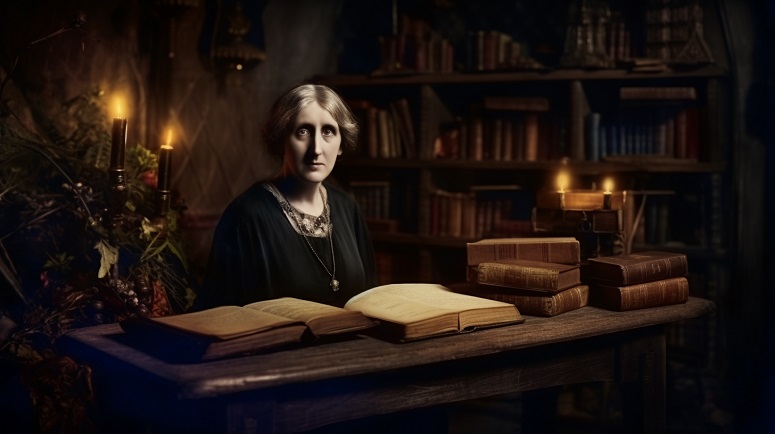Virginia Woolf: A Detailed Biography and Career of a Literary Trailblazer
Born: January 25, 1882, Kensington, London, United Kingdom
Died: March 28, 1941, Lewes, United Kingdom
Spouse: Leonard Woolf (m. 1912–1941)
Virginia Woolf, born Adeline Virginia Stephen on January 25, 1882, in London, England, was an influential British writer and one of the foremost figures of modernist literature. From a young age, Woolf displayed immense talent as a writer and thinker. As a member of the illustrious Bloomsbury Group – an intellectual gathering that included luminaries such as E.M. Forster and John Maynard Keynes – she became known for her experimental writing style and profound insights into the human psyche.
Woolf’s career flourished with the publication of her groundbreaking works. Her novels challenged conventional narrative structures by delving deeply into characters’ internal thoughts and perceptions rather than relying solely on external events.
Early life and family background
Virginia Woolf was born on January 25, 1882, in Kensington, London. She was the daughter of Sir Leslie Stephen, a renowned literary critic and historian, and Julia Prinsep Duckworth Stephen, a well-known model and nurse. Virginia came from a privileged background and grew up surrounded by intellectual conversations and artistic influences.
However, her childhood was marked by several tragic events. At the age of 13, she lost her mother to illness. This loss had a profound impact on Virginia’s mental health as she experienced her first episode of severe depression shortly after her mother’s death. Moreover, she also faced the untimely deaths of two half-siblings during her early years.
Despite these challenges, Virginia Woolf found solace in literature from an early age. Her father’s extensive library provided her with access to a wide range of books that fueled her imagination and passion for writing. As a child, she would often escape into the world of books and began experimenting with writing herself at a young age.
Growing up in such an environment shaped Virginia Woolf‘s future career as one of the most influential writers in modernist literature. The complexities of her early life experiences undoubtedly played a significant role in influencing both the themes and styles present in much of her later work.
Education and early writing influences
Virginia Woolf was born on January 25, 1882, and grew up in an intellectually stimulating household. Her father, Sir Leslie Stephen, was a renowned writer and historian, while her mother, Julia Prinsep Jackson, came from a prestigious family of artists and photographers. Growing up surrounded by books and art undoubtedly had a significant impact on Woolf’s early writing influences.
From an early age, Woolf received a rigorous education at home. She was taught Latin by her father and had access to his extensive library. This exposure to classical literature not only shaped her writing style but also instilled in her a love for language and the power of words. Additionally, she received formal education at the Ladies’ Department of King’s College London where she deepened her understanding of literature and honed her critical thinking skills.
Woolf’s early writing influences were further influenced by the vibrant literary circle known as the Bloomsbury Group. Through this group of intellectuals and artists that included E.M. Forster, Lytton Strachey, and Roger Fry among others, Woolf engaged in lively discussions about literature, art theory, feminism, psychology, and philosophy. These interactions played a crucial role in shaping her literary voice as well as expanding her intellectual horizons.
Virginia Woolf‘s education both within the confines of traditional schooling and within nurturing intellectual circles greatly influenced her early writing endeavors.
Formation of the Bloomsbury Group
Virginia Woolf, a prominent figure in the literary world, played a significant role in the formation and development of the Bloomsbury Group. Born on January 25, 1882, in London, she was part of an intellectual and artistic family that encouraged her creative pursuits. Woolf’s writing career began with her first novel “The Voyage Out” (1915), which received critical acclaim.
In addition to her individual achievements as a writer, Woolf fostered a network of like-minded individuals who shared her passion for art and literature. This group eventually became known as the Bloomsbury Group. The group was formed during the early 20th century and consisted of writers, artists, philosophers, and intellectuals who lived or worked in the Bloomsbury area of London.
Woolf’s home at Gordon Square became a hub for meetings and discussions among the members of this intellectual collective. It provided an environment where ideas could be freely exchanged and cultivated. The Bloomsbury Group challenged societal norms and conventional thinking through their radical perspectives on art, feminism, sexuality, pacifism, and social issues. Virginia Woolf‘s presence within this group greatly influenced its character and direction – her innovative writing style and feminist views helped shape the ethos that defined the Bloomsbury Group for years to come.
Note: The information provided is based on general knowledge about Virginia Woolf‘s life as well as historical references related to the formation of the Bloomsbury Group.
Literary achievements and major works
Virginia Woolf, a prominent figure in the modernist literary movement of the early 20th century, made significant contributions to literature through her innovative writing style and exploration of complex psychological themes. One of her major works, “Mrs Dalloway” (1925), is a groundbreaking novel that delves into the inner workings of its characters’ minds in a stream-of-consciousness narrative technique. It explores themes such as identity, social conventions, and the consequences of war on individuals.
Another notable literary achievement by Woolf is her novel “To the Lighthouse” (1927). This introspective work delves into the complexities of human relationships and perceptions of reality. Through its shifting perspectives and lyrical prose, Woolf challenges traditional narrative structures and offers readers a glimpse into the subjective experiences and emotions of her characters.
Woolf’s literary achievements extend beyond these novels to include numerous essays, reviews, and critical works. Her essay collection “A Room of One’s Own” (1929) addresses issues related to gender inequality in literature while advocating for women’s creative freedom. Additionally, she co-founded The Hogarth Press with her husband Leonard Woolf where they published works by other modernist writers including T.S. Eliot and E.M. Forster.
Overall, Virginia Woolf left an indelible mark on literature with her experimentation with form and profound exploration of human consciousness – transforming traditional storytelling techniques along the way while making significant contributions to feminist discourse within literary circles.
Personal struggles and mental health challenges
Virginia Woolf, a renowned writer and one of the foremost modernists of the 20th century, was not immune to personal struggles and mental health challenges. Throughout her life, she battled with recurring bouts of depression, which often left her feeling overwhelmed and isolated. These struggles were reflected in much of her writing, as she explored themes of mental illness and the fragility of the human psyche.
Woolf’s mental health challenges also manifested in other ways, such as her experiences with hallucinations and mood swings. At times, she would find herself engulfed in periods of intense creativity and productivity, only to be followed by debilitating episodes of withdrawal and despair. These fluctuations in her mental state greatly impacted both her personal life and professional career.
Despite these ongoing challenges, Woolf managed to produce some of the most influential works in English literature. Her novels like “Mrs Dalloway” and “To the Lighthouse” delve into complex psychological landscapes that reflect not only her own struggles but also shed light on broader societal issues surrounding mental health at that time. Through her writing, Woolf opened up conversations about mental illness that continue to resonate with readers today.
Legacy and impact on modern literature
Virginia Woolf was a pioneer of modern literature, leaving behind a lasting legacy that continues to shape the literary world today. Her innovative writing style and exploration of complex themes paved the way for future generations of writers. Woolf’s stream-of-consciousness technique, seen in works such as “Mrs Dalloway” and “To the Lighthouse,” revolutionized the way characters’ inner thoughts and emotions were portrayed in literature. This experimental approach not only challenged traditional narrative structures but also provided a deeper understanding of human psychology.
Furthermore, Woolf’s impact on modern literature can be seen through her feminist perspective and examination of gender roles. In her essay collection “A Room of One’s Own,” she passionately argued for women’s rights and their need for artistic freedom and individuality. This powerful message resonated with many female writers who followed in her footsteps, inspiring them to challenge societal norms and explore their own experiences through their writing. The feminist movement owes much to Woolf’s pioneering work, as it opened up new possibilities for women in literature and beyond.
In conclusion, Virginia Woolf has left an indelible mark on modern literature through her experimental writing style, exploration of complex themes, and feminist perspectives. Her influential works continue to inspire countless writers today, as they strive to push boundaries and delve into the depths of human experience. As we continue to celebrate her legacy, it is evident that Virginia Woolf remains one of the most important figures in literary history.
Conclusion: Virginia Woolf’s lasting literary legacy
Virginia Woolf‘s literary legacy is one that continues to resonate with readers and scholars alike. Her unique writing style, characterized by its stream-of-consciousness narrative and experimental structure, revolutionized the literary world and paved the way for future generations of writers. Moreover, her exploration of complex themes such as gender dynamics, mental health, and the human psyche served as a powerful commentary on society.
One of Woolf’s most notable contributions was her role in the development of feminist literature. Through works like “A Room of One’s Own” and “Three Guineas,” she challenged traditional gender roles and advocated for women’s rights. By highlighting the limitations imposed on women by a patriarchal society, Woolf encouraged female writers to find their voice and assert their independence.
Additionally, Woolf’s candid portrayal of mental illness has left an indelible mark on literature. As someone who suffered from depression herself, she was able to craft nuanced characters who grappled with their own internal struggles. Through novels like “Mrs Dalloway” and “To the Lighthouse,” she provided a sensitive portrayal of mental health issues that resonated with readers then and continues to do so today.
In conclusion, Virginia Woolf‘s lasting literary legacy can be found in her innovative writing style, thought-provoking themes, and unflinching depiction of societal norms. Her impact on feminist literature cannot be overstated – she laid the groundwork for future generations to challenge existing power structures.












